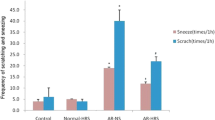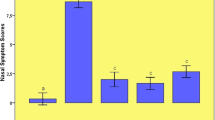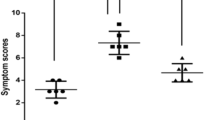Abstract
It is well known that CD4+CD25+Foxp3+Treg cells play an important role in the development of allergic rhinitis (AR); the defect of cell numbers and functions contribute to AR. Hydrogen has been proven effective in alleviating symptoms of AR. We herein aim to verify the protective effects of hydrogen on CD4+CD25+Foxp3+Treg cells in guinea pigs with AR and to explore the effect of hydrogen-rich saline (HRS) on CD4+CD25+Foxp3+Treg cells in animals with AR and investigate the underlying anti-inflammatory mechanism. Eighteen guinea pigs were randomly divided into three groups (control group/AR group/AR-HRS group). The guinea pigs were injected with hydrogen-rich saline (AR-HRS group) for 10 days after sensitization. The control group was injected with an equal volume of normal saline. The number of sneezes, degree of runny nose, and nasal-rubbing movements were scored. Peripheral blood eosinophil count was recorded. The proportions of Th1/Th2 of the peripheral blood and the CD4+CD25+Foxp3+T cells in the CD4+T cells of the spleen and peripheral blood were determined by flow cytometry. The content of interleukin (IL)-10 and transforming growth factor (TGF)-β in the serum was detected by enzyme-linked immunosorbent assay (ELISA). The protein and mRNA expression of Foxp3, IL-10, and TGF-β were determined by Western blot, immunofluorescence, and real-time PCR analysis, respectively. Scores of symptoms, number of eosinophils,and nasal mucosa damage were dramatically reduced after HRS treatment. HRS increased the expression of Foxp3, IL-10, TGF-β, and number of CD4+CD25+Foxp3+Treg cells, which were reduced in AR. HRS also revised the dysregulation of Th1/Th2 balance. Both the number and biological activity of CD4+CD25+Foxp3+Treg cells increased with up-regulation of Th1/Th2 after HRS administration. HRS could play a protective role in attenuating AR through improving the proportion and functions of CD4+CD25+Foxp3+Treg cells.





Similar content being viewed by others
References
Hellgren, J., A. Cervin, S. Nordling, A. Bergman, and L.O. Cardell. 2010. Allergic rhinitis and the common cold—high cost to society. Allergy 65 (6): 776–783.
Haque, M., K. Fino, F. Lei, X. Xiong, and J. Song. 2014. Utilizing regulatory T cells against rheumatoid arthritis. Frontiers in Oncology 4 (2): 209.
Huang, X., Y. Chen, F. Zhang, Q. Yang, and G. Zhang. 2014. Peripheral Th17/Treg cell-mediated immunity imbalance in allergic rhinitis patients. Brazilian Journal of Otorhinolaryngology 80 (2): 152–155.
Frew, A.J. 2008. Sublingual immunotherapy. New England Journal of Medicine 358 (21): 2259–2264.
Zheng, X.F., X.J. Sun, and Z.F. Xia. 2011. Hydrogen resuscitation, a new cytoprotective approach. Clinical and Experimental Pharmacology & Physiology 38 (3): 155–163.
Xiao, M., T. Zhu, T. Wang, and F.Q. Wen. 2013. Hydrogen-rich saline reduces airway remodeling via inactivation of NF-kappaB in a murine model of asthma. European Review for Medical & Pharmacological Sciences 17 (8): 1033–1043.
Yu, S., C. Zhao, N. Che, L. Jing, and R. Ge. 2017. Hydrogen-rich saline attenuates eosinophil activation in a guinea pig model of allergic rhinitis via reducing oxidative stress. Journal of Inflammation 14 (1): 1.
Zhao, C., S. Yu, J. Li, W. Xu, and R. Ge. 2017. Changes in Il-4 and Il-13 expression in allergic-rhinitis treated with hydrogen-rich saline in guinea-pig model. Allergologia Et Immunopathologia International Journal for Clinical & Investigate Allergology & Clinical Immunology 45: 350–355.
Cai, J., Z. Kang, K. Liu, W. Liu, R. Li, J.H. Zhang, X. Luo, and X. Sun. 2009. Neuroprotective effects of hydrogen saline in neonatal hypoxia—ischemia rat model. Brain Research 1256: 129–137.
Ohsawa, I., M. Ishikawa, K. Takahashi, M. Watanabe, K. Nishimaki, K. Yamagata, K. Katsura, Y. Katayama, S. Asoh, and S. Ohta. 2007. Hydrogen acts as a therapeutic antioxidant by selectively reducing cytotoxic oxygen radicals. Nature Medicine 13 (6): 688–694.
Narita, S.I., K. Asakura, and A. Kataura. 1996. Effects of thromboxane A2 receptor antagonist (bay u 3405) on nasal symptoms after antigen challenge in sensitized guinea pigs. International Archives of Allergy and Immunology 109 (2): 161–166.
Buchholz, B.M., D.J. Kaczorowski, R. Sugimoto, R. Yang, Y. Wang, T.R. Billiar, K.R. McCurry, A.J. Bauer, and A. Nakao. 2008. Hydrogen inhalation ameliorates oxidative stress in transplantation induced intestinal graft injury. American Journal of Transplantation 8 (10): 2015–2024.
Nakashima-Kamimura, N., T. Mori, I. Ohsawa, S. Asoh, and S. Ohta. 2009. Molecular hydrogen alleviates nephrotoxicity induced by an anti-cancer drug cisplatin without compromising anti-tumor activity in mice. Cancer Chemotherapy and Pharmacology 64 (4): 753–761.
Vignola, A.M., G. Chiappara, R. Gagliardo, M. Gjomarkaj, A. Merendino, L. Siena, J. Bousquet, and G. Bonsignore. 2000. Apoptosis and airway inflammation in asthma. Apoptosis 5 (5): 473–485.
Druilhe, A., S. Letuve, and M. Pretolani. 2003. Glucocorticoid-induced apoptosis in human eosinophils: mechanisms of action. Apoptosis 8 (5): 481–495.
Sakaguchi, S., N. Sakaguchi, M. Asano, M. Itoh, and M. Toda. 1995. Immunologic self-tolerance maintained by activated T cells expressing IL-2 receptor alpha-chains (CD25). Breakdown of a single mechanism of self-tolerance causes various autoimmune diseases. The Journal of Immunology 155 (3): 1151–1164.
Lehtimäki, S., and R. Lahesmaa. 2013. Regulatory T cells control immune responses through their non-redundant tissue specific features. Frontiers in Immunology 4: 294.
Braga, M., C. Quecchia, E. Cavallucci, L. Di Giampaolo, C. Schiavone, C. Petrarca, and M. Di Gioacchino. 2011. T regulatory cells in allergy. International Journal of Immunopathology and Pharmacology 24 (1 Suppl): 55S–64S.
Taylor, A., J. Verhagen, C.A. Akdis, and M. Akdis. 2005. T regulatory cells and allergy. Microbes and Infection 7 (7): 1049–1055.
Robinson, D.S., M. Larché, and S.R. Durham. 2004. Tregs and allergic disease. Journal of Clinical Investigation 114 (10): 1389–1397.
Han, D., L. Xi, E. Fan, Y. Li, and L. Zhang. 2009. Expression of the Foxp3 gene in spleen mononuclear cells of a mouse model with allergic rhinitis. ORL 71 (6): 317–322.
Xu, G., Z. Mou, H. Jiang, L. Cheng, J. Shi, R. Xu, Y. Oh, and H. Li. 2007. A possible role of CD4+ CD25+ T cells as well as transcription factor Foxp3 in the dysregulation of allergic rhinitis. The Laryngoscope 117 (5): 876–880.
Radulovic, S., M.R. Jacobson, S.R. Durham, and K.T. Nouri-Aria. 2008. Grass pollen immunotherapy induces Foxp3-expressing CD4+ CD25+ cells in the nasal mucosa. Journal of Allergy and Clinical Immunology 121 (6): 1467–1472.
Zhou, H.T., X.Z. Huang, X.Z. Wu, W.Y. Chen, and X.B. Wu. 2013. Bone marrow-derived dendritic cells rather than spleen-derived dendritic cells can generate regulatory T cells. Journal of Experimental Hematology 21 (4): 1015–1020.
Sakaguchi, S., K. Wing, Y. Onishi, P. Prieto-Martin, and T. Yamaguchi. 2009. Regulatory T cells: how do they suppress immune responses? International Immunology 21 (10): 1105–1111.
Larché, M., C.A. Akdis, and R. Valenta. 2006. Immunological mechanisms of allergen-specific immunotherapy. Nature Reviews. Immunology 6 (10): 761–771.
Ozdemir, C., M. Akdis, and C.A. Akdis. 2009. T regulatory cells and their counterparts: masters of immune regulation. Clinical & Experimental Allergy 39 (5): 626–639.
Liu, K.S., X.Q. Fan, L. Zhang, Q.N. Wen, J.H. Feng, F.C. Chen, J.M. Luo, and W.B. Sun. 2014. Effects of recombinant human interleukin-10 on Treg cells, IL-10 and TGF-β in transplantation of rabbit skin. Molecular Medicine Reports 9 (2): 639–644.
Chen, W., W. Jin, N. Hardegen, K.J. Lei, L. Li, N. Marinos, G. McGrady, and S.M. Wahl. 2003. Conversion of peripheral CD4+ CD25-naive T cells to CD4+ CD25+ regulatory T cells by TGF-β induction of transcription factor Foxp3. Journal of Experimental Medicine 198 (12): 1875–1886.
Luo, C.Y., L. Wang, C. Sun, and D.J. Li. 2011. Estrogen enhances the functions of CD4+ CD25+ Foxp3+ regulatory T cells that suppress osteoclast differentiation and bone resorption in vitro. Cellular and Molecular Immunology 8: 50–58.
Guzman-Flores, J.M., and D.P. Portales-Perez. 2012. Mechanisms of suppression of regulatory T-cells (Treg). Gaceta Medica de Mexico 149 (6): 630–638.
König, K., C. Klemens, K. Eder, M. San Nicoló, S. Becker, M.F. Kramer, and M. Gröger. 2015. Cytokine profiles in nasal fluid of patients with seasonal or persistent allergic rhinitis. Allergy, Asthma & Clinical Immunology 11 (1): 26.
Anderson, A.E., K.J. Mackerness, M. Aizen, V.A. Carr, D. Nguyen, F.D. Pre, S.R. Durham, and D.S. Robinson. 2009. Seasonal changes in suppressive capacity of CD4+ CD25+ T cells from patients with hayfever are allergen-specific and may result in part from expansion of effector T cells among the CD25+ population. Clinical & Experimental Allergy 39 (11): 1693–1699.
Tan, C., M.K. Aziz, J.D. Lovaas, B.P. Vistica, G. Shi, E.F. Wawrousek, and I. Gery. 2010. Antigen-specific Th9 cells exhibit uniqueness in their kinetics of cytokine production and short retention at the inflammatory site. The Journal of Immunology 185 (11): 6795–6801.
Marson, A., K. Kretschmer, G.M. Frampton, E.S. Jacobsen, J.K. Polansky, K.D. MacIsaac, S.L. Stuart, E. Fraenkel, H. von Boehmer, and R.A. Young. 2007. Foxp3 occupancy and regulation of key target genes during T-cell stimulation. Nature 445 (7130): 931–935.
Hori, S., T. Nomura, and S. Sakaguchi. 2003. Control of regulatory T cell development by the transcription factor Foxp3. Science 299 (5609): 1057–1061.
Lee, S.M., B. Gao, M. Dahl, K. Calhoun, and D. Fang. 2009. Decreased FoxP3 gene expression in the nasal secretions from patients with allergic rhinitis. Otolaryngology—Head and Neck Surgery 140 (2): 197–201.
Okamoto, A., K. Fujio, T. Okamura, and K. Yamamoto. 2011. Regulatory T-cell-associated cytokines in systemic lupus erythematosus. BioMed Research International 2011 (4): 463412.
O'garra, A., and P. Vieira. 2004. Regulatory T cells and mechanisms of immune system control. Nature Medicine 10 (8): 801–805.
Acknowledgements
This project was sponsored by the grants from the doctoral program of the Ministry of Education (20130072120022) and Western Medicine guide project of Shanghai City (17411970500).
Author information
Authors and Affiliations
Corresponding author
Ethics declarations
The research was approved by the Tongji University Institution Animal Care and Use Committee (2017-DW-002).
Conflict of Interest
The authors declare that they have no conflicts of interest.
Rights and permissions
About this article
Cite this article
Xu, F., Yu, S., Qin, M. et al. Hydrogen-Rich Saline Ameliorates Allergic Rhinitis by Reversing the Imbalance of Th1/Th2 and Up-Regulation of CD4+CD25+Foxp3+Regulatory T Cells, Interleukin-10, and Membrane-Bound Transforming Growth Factor-β in Guinea Pigs. Inflammation 41, 81–92 (2018). https://doi.org/10.1007/s10753-017-0666-6
Published:
Issue Date:
DOI: https://doi.org/10.1007/s10753-017-0666-6




